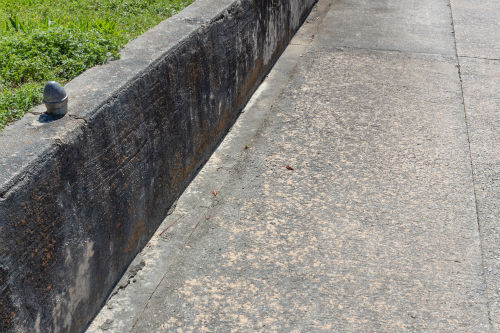In landscaping and construction, there are often natural obstacles that require man-made workarounds to overcome. One of these obstacles is the presence of soil and the potential for it to shift over time, causing undesirable outcomes. Depending on the lay of the land, a concrete retaining wall may be the best solution for unwanted soil movement.
If you’ve ever driven down the highway, you may have noticed many miles of concrete walls lining both sides of the road. A large portion of these are retaining walls that prevent soil from shifting and spilling out onto the pavement. In this way, the wall retains the soil from moving in a natural pattern. Soil that is being held back by a retaining wall is referred to as backfill.
Retaining walls are found in a variety of sizes, styles, and materials, from stones, rocks and boulders to masonry and even wood. Wood is not recommended for modern retaining walls as it has a shorter lifespan and is vulnerable to moisture and intrusion by plants and animals. When it comes to retaining walls, the strongest are made from cast-in-place or poured concrete.
How Poured Concrete Retaining Walls are Built
Concrete is incredibly versatile and can be poured in a variety of shapes, sizes, and orientations. Poured concrete retaining walls are built from the ground up, and their design is dependent on a variety of factors from ground and soil conditions to wall height, construction time and overall cost.
The basic structure of a concrete retaining wall includes interior rebar reinforcement with an exterior concrete shell that resembles an upside-down T. The footing of the wall extends out, allowing backfill to act as additional support to keep the wall straight.
Once wall construction is complete, a drainage system is installed on the back end of the wall and surrounded by gravel to precipitate proper water flow. Backfill is then added to cover this and any remaining exposed concrete.
Challenges of Concrete Retaining Walls

Although arguably the best option for a retaining wall, poured concrete walls often require expert design. An improperly constructed concrete retaining wall can lead to several major issues. It is for this reason that most concrete retaining walls are built for commercial applications by professional concrete contractors and engineers. While they can be an option for residential use, their complexity and high cost make them less favorable than most alternatives.
One of the biggest challenges associated with concrete retaining walls is their inherent demand for perfection. The construction of the wall has to be perfect, down to a T–literally. Any mistakes could result in bulges or waves in the wall that can lead to bigger problems.
On top of that, the concrete tamping needs to be perfect as well–and tamping poured concrete for retaining walls presents a unique challenge in that it requires navigating through and around substantial amounts of rebar. A poorly-tamped concrete retaining wall will result in an unsmooth surface.
When to Use a Concrete Retaining Wall
Concrete retaining walls can be seen anywhere from highways to inner city streets and parks, industrial and business complexes and everywhere in between. They are most often built for commercial purposes due to their high cost and required skill level. However, when cost is not an issue and access to these skill sets is available, concrete can be a very solid option for a residential retaining wall.
While concrete retaining walls are usually used to prevent undesired soil movement, they can also be decorative. Some styles of concrete retaining walls even have the look and feel of stone masonry. However, there are many alternatives to poured concrete walls that may be a better option if only being used for decorative purposes.
Concrete retaining walls are far stronger than alternative materials, making them ideal for situations where continuous, significant wear and tear is expected. They can be used in a variety of climates, as admixtures can be added to adjust for environmental factors that may contribute to erosion, cracking, and other moisture-related issues.
Regardless of the reasoning behind a poured concrete retaining wall, one thing is certain: with the proper skillset, planning, tools and execution, a concrete wall will not only look beautiful and impressive, but will also last a lifetime.

